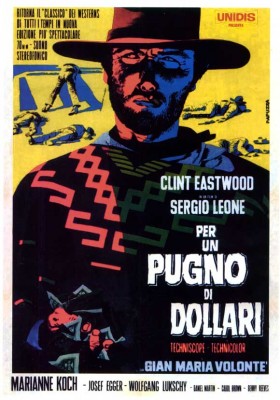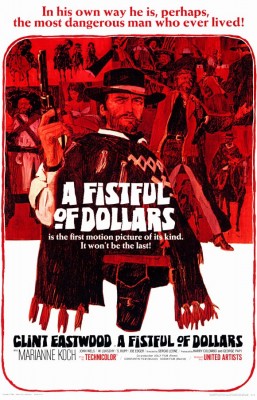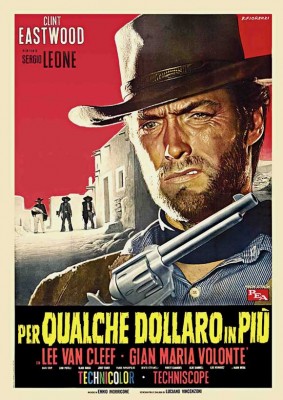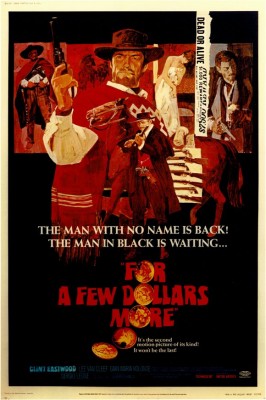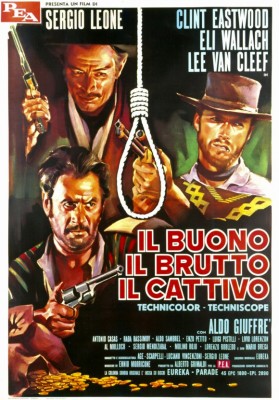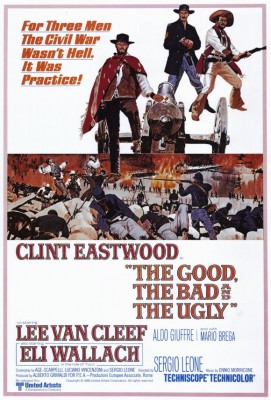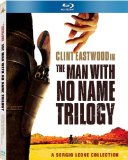| Reviews & Columns |
|
Reviews DVD TV on DVD Blu-ray 4K UHD International DVDs In Theaters Reviews by Studio Video Games Features Collector Series DVDs Easter Egg Database Interviews DVD Talk Radio Feature Articles Columns Anime Talk DVD Savant Horror DVDs The M.O.D. Squad Art House HD Talk Silent DVD
|
DVD Talk Forum |
|
|
| Resources |
|
DVD Price Search Customer Service #'s RCE Info Links |
|
Columns
|
|
|
Man with No Name Trilogy (Fistful of Dollars / For a Few Dollars More / The Good, the Bad, and the Ugly), The
Almost alarmingly packaged in a normal-sized Blu-ray case (Are there really three discs in there?), MGM's The Man with No Name Trilogy virtually dumps onto the market great new transfers of the first two movies, both new to high-def while, alas, The Good, the Bad, and the Ugly utilizes the same pointlessly de-textured transfer first released in May 2009.
Curiously, the packaging barely mentions the exhaustive extra features. Though consisting almost entirely of material from earlier DVD releases, they're undeniably plentiful and informative - and there is a tiny bit of new material (also in high-def), though only just.
Fistful of Dollars (Not "A Fistful of Dollars"; that was only on the posters) was not the first Euro-Western. There had been a handful of Italian oaters before this, but they were cheap if occasionally entertaining knock-offs of American Westerns, sometimes with imported American stars. Spain was enjoying a mini-resurgence, while the grandly Old School West German-Yugoslavian Karl May adaptations featuring Lex Barker as Old Shatterhand and Pierre Brice as the Indian Winnetou were a sensation elsewhere on the European Continent.
In this environment relative neophyte director Leone, who previously had mostly worked as a second unit director and uncredited replacement for other filmmakers (a not uncommon practice in Italy at the time, apparently) found himself supervising a cheap - estimates say $200,000 but the amount may have been even lower - Italian-Spanish-West German co-production originally entitled "The Magnificent Stranger."
The story, about a mysterious gunfighter (Eastwood) who arrives in a decimated Mexican border town and engineers the destruction of its two rival gangs, was a blatant, uncredited steal of Akira Kurosawa's 1961 chanbara masterpiece Yojimbo. And it wasn't just the story: while Fistful of Dollars has its wholly original scenes, certain details directly, shamelessly imitate Kurosawa's film. For instance the bell-ringer Joe meets as he arrives in San Miguel is nearly a twin of Ikio Sawamura, the tiny Japanese actor who played the part in Kurosawa's film. Even Morricone's score, while innovative and exciting, counters genre expectations in the same jazzy, ironic, and eccentrically orchestrated manner as Masaru Sato's groundbreaking score for Kurosawa.
Leone made no bones about adapting Yojimbo during the writing and production of Fistful of Dollars. Later, when Kurosawa sent him a letter saying, "I have just had a chance to see your film. It is a very fine film, but it is my film. ... You must pay me," Leone was too flattered by what he interpreted as a compliment to fully comprehend its legal implications. In the end, Kurosawa was awarded 15% of the worldwide receipts and distribution rights to the film in Japan and other parts of Asia.
That said, Leone was undeniably clever in his reworking of the material, much as the Japanese had retooled American film noir and gangster films into Yakuza melodramas, which at first were cheaply imitative potboilers then uniquely Japanese and even artful examples of outlaw cinema. Leone's masterful direction only fitfully emerges in Fistful of Dollars, but the foundation is laid.
The film's first half which, notably, follows Yojimbo more closely, remains lively and entertaining while its second half is much more routine, less interesting, and even dull in repeated viewings. But Eastwood's morally ambiguous master gunfighter is a real achievement, translated but also transformed from Toshiro Mifune's iconic ronin into something original also. (***)
For a Few Dollars More (Per qualche dollaro in più) is a vast improvement over its imitative if genre-busting predecessor, with a greater emphasis on story and characterization. Leone's style is still omnipresent, in spades, but it enhances a compelling story. And while Leone cribs bits and pieces from American Westerns all over the place, here he consistently turns it all on its head, making it his own, while at the same time he markedly distances himself from what Leone later described as the "gold rush" of Italian filmmakers now rushing to imitate his success.
"Manco" (Clint Eastwood) and Colonel Mortimer (Lee Van Cleef) are bounty hunters working independently, competing to see who can kill or capture "El Indio" ("the Indian," played by Gian Maria Volontè), a psychotic and possibly drug-addicted fugitive. With his equally unsavory gang, including a wild-eyed hunchback (Klaus Kinski, in a variation of his usual krimi roles), El Indio is planning to rob the fortress-like Bank of El Paso, its treasures hidden in a disguised safe. Reluctantly, Manco and Mortimer decide to team up, Mortimer instructing Manco to infiltrate Indio's band by breaking another of their gang out of jail.
Produced on a budget nearly three times that of Fistful of Dollars, For a Few Dollars More really was, and it's up there on the screen, with lavishly appointed and (an obsession of the director's) historically accurate set decoration and props. On Blu-ray this aspect of the film really comes alive.
The screenplay by Leone, Fulvio Montella, and Luciano Vincenzoni (with English dialogue retooled by Eastwood and Van Cleef) is also much stronger, with more interesting character interaction between Manco and Mortimer - in one memorable scene they face off in the street, repeatedly shooting at each other's hats, trying to intimidate the other - as well as between Manco and Indio. Unlike Fistful of Dollars where Leone didn't follow Kurosawa's lead in making plain the various characters' spatial/geographical relationships, in For a Few Dollars More, Indio's plans to rob the bank are better dramatized so that the events leading up to the robbery are tense and exciting.
(Mild Spoilers) Rather surprisingly, at its center is not Eastwood but Lee Van Cleef, giving the performance of his career. Where Eastwood's morally ambiguous gunman is simultaneously more humorous and cold-blooded this time out (he kills Indio's gang off much more casually than his gunfights in Fistful), Van Cleef's then atypical casting as a bounty hunter methodically and dedicatedly trying to avenge his sister's death is, by the end, almost touching. Van Cleef had been kicking around Hollywood for years, nearly always as a baddie - he was one of Frank Miller's gang in High Noon (1952) - but his career had been in steady decline after a serious automobile accident that shattered a kneecap and limited his mobility. His performance in this and Good, the Bad, and the Ugly secured him steady employment for the rest of his life. (****)
Though I consider Leone's Once Upon a Time in the West (1967) to be his masterpiece and one of the greatest films of all-time (Western or not), The Good, the Bad, and the Ugly (Il buono, il brutto, il cattivo, "The Good, the Ugly, the Bad," 1966) has one memorable scene after another and numerous flashes of greatness. It is, arguably, Leone's most entertaining, satisfying work.
Set against the backdrop of the American Civil War, albeit in Texas and New Mexico, the third film of Leone's "Dollars" trilogy is a labyrinthine tale of three unscrupulous gunslingers each searching for a fortune in hidden Confederate gold, secretly buried in a forgotten grave. They may be motivated by greed, but Leone implies that even that is preferable to the brutality and futility of the war around them, which each navigates through like a steamship through an ocean full of icebergs. Like the ads said, "For three men the Civil War wasn't Hell. It was practice!"
Bounty hunter Blondie (Eastwood), the "Good," as with Eastwood's other Men with No Names, has a biting, cynical sense of humor but otherwise plays his cards close to his chest. Angel Eyes (Lee Van Cleef), the "Bad," is a ruthless and unfeeling cold-blooded killer. Tuco (Eli Wallach), actually, Tuco Benedicto Pacífico Juan María Ramírez, the "Ugly," is greedy, sweaty, immoral, coarse, and every other negative adjective you can think of. Excellent though Eastwood and Van Cleef are in this, The Good, the Bad, and the Ugly hands-down is Eli Wallach's movie. Loosely suggested by Wallach's Mexican bandito in The Magnificent Seven (1960) and his killer in "The Railroads" segment of How the West Was Won (1962), Wallach creates one of cinema's all-time great characters, a true original, simultaneously appealing and contemptible. Wallach is as far removed from Tuco as can be imagined. (I'll bet the vast majority who see the film believe Wallach to be Mexican or Spanish. He is in fact Jewish and from New York City.)
The skyrocketing popularity of Leone's films justified his biggest budget yet: $1.3 million. By American standards that was extremely modest, but the dollar went a lot further in Spain and Italy than it did in America. Some of the battle scenes are truly epic, and Leone's efforts to be more historically accurate partly obscure its Almeria origins, though its Spanish and Italian cast gives it away. In any case, it far out-classed the Spaghetti Westerns by this point flooding the market.
The film premiered in Italy with a running time of 177 minutes but was cut by 16 minutes for its American release, which nonetheless grossed $6.3 million. Worldwide, it was by far the most successful Spaghetti Western ever.
The film has many memorable moments, beginning with the opening titles, whose music by Ennio Morricone all but became the Italian Western's signature theme. (Ingeniously, each of the leads get his own variation of the five-note cue: Eastwood's is a soprano flute, Van Cleef's an arghilofono, and screaming human voices for Wallach's.)
Equally memorable - one of the best fusings of Leone'e and Morricone's genius, topped only by several sequences in Once Upon a Time in America - is the "Ecstasy of the Gold" sequence, in which Tuco runs around a circular cemetery in search of a particular tombstone. As Morricone's music builds to a fever pitch, Leone's use of a long lens dizzyingly following the increasingly frantic Tuco creates a truly hypnotic effect. The final showdown between Blondie, Angel Eyes, and Tuco is, debatably, the best in the entire Western genre.
The Blu-ray includes the film's complete, 2002 reconstruction, which went so far as to have Eastwood and Wallach re-loop their long-lost guide-track dialogue from the cut footage. (Simon Prescott does a decent imitation of Van Cleef in these scenes.) The reinstated footage markedly increases the film's impact and fleshes out several characters. (**** 1/2)
Video & Audio
All three films were shot in Techniscope, an inexpensive alternative to CinemaScope. Essentially, Techniscope used half as much raw film stock as conventional 35mm by exposing frames as wide as regular 35mm but half as tall - two perforations (i.e., sprocket holes) instead of the usual four. Anamorphic lenses were not required during production (because the exposed frame shape was already widescreen) thus allowing greater depth of field and less distortion than anamorphic processes. The downside was that release prints, optically squeezed and enlarged like standard 35mm 'scope, tended to be on the grainy side.
When HD TVs, HD DVD, and Blu-ray were brand-new I had my doubts about how a process like Techniscope would fare in high-definition. But then around 2006 I caught a high-def broadcast of For a Few Dollars More on Japan's NHK network and was dazzled by the results. Yes, the image was grainy but pleasingly so; more important was that the subtlety of the colors and lighting, and the texture of the wardrobe and sets and especially the actors' faces in those glorious Leone extreme close-ups jumped off the screen. I was sold.
But then MGM's Blu-ray of The Good, the Bad, and the Ugly came along. It lacked - and still lacks - all of those qualities. It's a slight improvement over earlier DVD editions, but not much. It's not exactly overprocessed with DNR in the Fox Home Entertainment manner; the actors' faces don't look waxy, for instance, but there's an obvious attempt to scrub the grain away. I'm reminded of the time I once had cable TV installed and the signal looked awful. "I'll fix that!" enthused the cable guy, who grabbed my TV remote, pressed the "sharpness" button and turned it all the way to "zero." Yeah, right. Looks great.**
Conversely, the transfer of Fistful of Dollars is quite decent. Shortly before leaving MGM I saw a brand-new print of the film in one of their screening rooms and it didn't look nearly as good as this does. And For a Few Dollars More looks as exceptional as that NHK broadcast version, with some shots absolutely gorgeous. I was particularly impressed at how much better textures like leather (note Eastwood's hat in the pouring rain) and wood grain (you can almost smell the varnish in the saloon) come off on this. Overall the transfers rate thusly: A Fistful of Dollars (****); For a Few Dollars More (**** 1/2); The Good, the Bad, and the Ugly (** 1/2).
The 5.1 DTS-HD Master Audio on all three films is fine, including even directionality coming from the hoofs of the galloping cartoon horses and cannons during the opening titles. (The titles for Fistful, incidentally, credit Leone as director. Early prints, even in Italy, Anglicized the names of many in the cast and crew, with Leone credited as "Bob Robertson.") Included are (on Fistful) a 5.1 Dolby Digital French track, original English and Spanish mono tracks, and subtitles in all three languages; same but with no French options on For a Few Dollars More; and, on The Good, the Bad, and the Ugly, adds a German 5.1 DTS and Spanish and Protuguese 5.1 Dolby Digital track, with subtitles in all those languages plus Korean, Cantonese, Mandarin, and Thai.
Reportedly, the Italian rights holders are famously uncooperative which may explain why Italian audio is absent from Fistful of Dollars and For a Few Dollars More. Clearly, there's also a place for an intermission cue during the first two films that's absent, and neither film has exit music.
Extra Features
Each disc is packed with supplements: audio commentaries, featurettes, trailers and radio spots, etc., though nearly all of this has been released before, notably on MGM's "Ultimate Edition" DVDs from 2007, though a few trailers have been bumped up to high-def.
What's new are two high-def featurettes, The Frayling Archives, which accompany Fistful of Dollars and For a Few Dollars More. It's an unusual concept that works extremely well. Leone biographer Sir Christopher Frayling displays for the camera highlights from his personal collection of international posters, pressbooks, lobby cards, etc., all the while explaining not only what everything is, but also noting how the evolution of the series and its spreading influence is reflected in the poster art of various territories. It's fascinating stuff. (I'd be very surprised if Frayling didn't also shoot material for The Good, the Bad, and the Ugly at the same time these were made. However, adding it to that title would have meant redoing the disc.)
Regrettably, that's it as far as new material, but the older stuff is consistently excellent. Previously released material includes: Audio commentaries by Christopher Frayling on all three films; an audio commentary by Richard "I hate my job" Schickel on The Good, the Bad, and the Ugly. Fistful and For a Few Dollars More both feature interviews with Eastwood and Tre Voci ("Three Friends") of Leone's (producer Alberto Grimaldi, writer Sergio Donati, and actor Mickey Knox); director Monte Hellman discusses the bizarre, fascinating prologue he shot for a 1977 network television premiere of Fistful, featuring Harry Dean Stanton and a double standing in for Eastwood; that prologue is also included in its entirety. Other featurettes include a two-part portrait of Ennio Morricone and a look at the extensive restoration/reconstruction of The Good, the Bad, and the Ugly.
Parting Thoughts
Though it's a shame MGM did not see fit to remaster The Good, the Bad, and the Ugly after so many complaints about its transfer, the fine job given both Fistful of Dollars and especially For a Few Dollars More justifies a purchase, especially if you don't already own Good, the Bad, and the Ugly. The two new extras are slight but very worthwhile, and the older extras remain excellent. Highly Recommended.
* Sergei Hasenecz writes, "It should be noted that he is called by those names, but he himself never says his name. This makes a difference, as well as being a twist on the character who inspired him. Mifune's wandering swordsman makes up names on the spur of the moment. Eastwood's gunfighter is given names by others."
** For a few notes more. Sergei adds, "I can top that. I had a long-running feud with Adelphia over picture quality, particularly on the higher channels including (of course!) Turner Classics. When one cable guy arrived, I put on TCM to show him that the picture was fuzzy. He watched the black-and-white movie for a minute, then shrugged and said, 'It's an old movie!' I exploded."
Stuart Galbraith IV's latest audio commentary, for AnimEigo's Musashi Miyamoto DVD boxed set, is on sale now.
|
| Popular Reviews |
| Sponsored Links |
|
|
| Sponsored Links |
|
|
| Release List | Reviews | Shop | Newsletter | Forum | DVD Giveaways | Blu-Ray | Advertise |
|
Copyright 2024 DVDTalk.com All Rights Reserved. Legal Info, Privacy Policy, Terms of Use,
Manage Preferences,
Your Privacy Choices | |||||||









